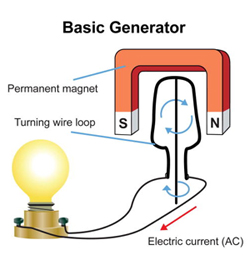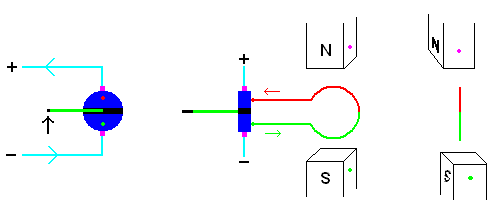


DC generator (animation)
The animation above looks strikingly similar to the DC motor animation introduced in the last section. It should! An electrical generator is an electric motor turned backwards. This is similar to the discussion of the water wheel and the pump. As you recall, in the case of a water wheel, the wheel receives energy from the falling water and therefore starts turning. The pump also has a wheel but in this case, the spinning wheel delivers energy to the fluids ... creating pressure differences and making the water flow. An electric motor (like the water wheel) has an armature which is compelled to spin when current is fed through a wire, and its corresponding magnetic field interacts with a permanent magnet. An electric generator (like the water pump) has an armature which, when forced to spin in a magnetic field, will induce currents to flow through the wire. In other words:
A motor converts electrical energy to rotational kinetic energy ... a generator converts rotational kinetic energy to electrical energy!
The idea is simple ... you can make current flow in a wire provided the wire is in a changing magnetic field. The spinning armature "sees" the permanent external magnets as a changing field, so current is induced in the wires of the armature. Thank you, Michael Faraday and Joseph Henry.
Consider the animation (applet) below. This applet demonstrates that you generate DC current if you choose "with commutator", or AC current if you choose "without commutator". In either case you should see that the power delivered is not steady, but swings from zero to a maximum value and then back to zero.
Java Applet courtesy of
Walter Fendt
Click here to see an applet of an AC generator and click here to see an applet of a DC generator.